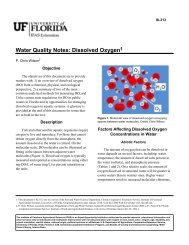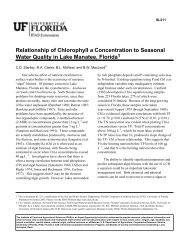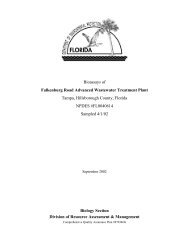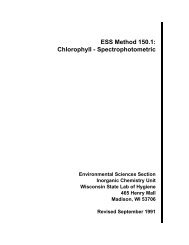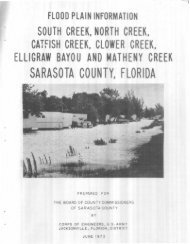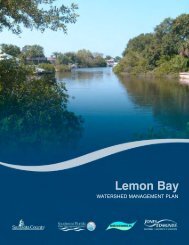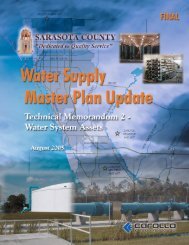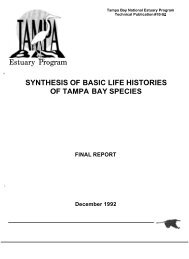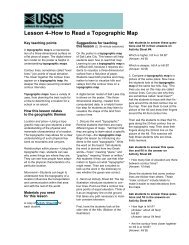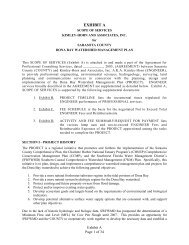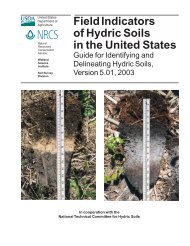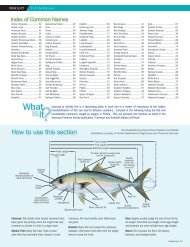Peace and Myakka River Water Quality Summary 2002 - Southwest ...
Peace and Myakka River Water Quality Summary 2002 - Southwest ...
Peace and Myakka River Water Quality Summary 2002 - Southwest ...
Create successful ePaper yourself
Turn your PDF publications into a flip-book with our unique Google optimized e-Paper software.
Secchi DepthSecchi depth — the average depth at which a st<strong>and</strong>ardized (20 cm diameter) white orblack-<strong>and</strong>-white disk disappears <strong>and</strong> reappears when lowered into the water columnfrom the deck of a boat or dock — is a simple measure of water transparency. Becausetransparency is affected by a number of factors, including water color, TSS <strong>and</strong>turbidity, Secchi depths can exhibit substantial temporal <strong>and</strong> spatial variability within <strong>and</strong>between water bodies. Median statewide Secchi depth values for Florida rivers <strong>and</strong>estuaries, reported by Friedemann <strong>and</strong> H<strong>and</strong> (1989), are 0.8 m <strong>and</strong> 1.1 m, respectively.Median Secchi depth values for the tidal <strong>Peace</strong> <strong>and</strong> <strong>Myakka</strong> <strong>River</strong> stations are shown inAppendix B. The lowest median values were recorded at the most upstream stations(CH-001 <strong>and</strong> CH-029) in both river systems, presumably reflecting the high color <strong>and</strong>turbidity levels that occurred at those sites. In general median Secchi depths appearedto increase along the salinity gradient in both rivers, although reductions occurred atstations CH-02B <strong>and</strong> CH-05B. Both of these stations were located in shallow shorelineembayments away from the rivers’ main stems, where water transparency may havebeen affected by site-specific factors.Near-Surface pHpH is a measurement of the acidity of a water sample. Values 7 are considered basic or “alkaline.” Due to theirchemical characteristics, marine <strong>and</strong> estuarine waters tend to be more highly bufferedthan fresh water systems, usually exhibiting pH values in the range of 7.8 to 8.3(marine) or 7.5 to 8.8 (estuarine) st<strong>and</strong>ard units (Day et al. 1989).Highly acidic (ph < 4.5) or basic (pH > 9.5) conditions, which can occur due to a varietyof natural or man-made factors, can be harmful or fatal to aquatic organisms, eitherdirectly or due to increased mobilization or toxicity of other substances in theenvironment.pH values varied over a relatively narrow range at the tidal <strong>Peace</strong>-<strong>Myakka</strong> stations(Appendix B), with annual median values at each station ranging between 6.8 <strong>and</strong> 7.9units. Among the individual monthly readings the most acidic value (5.5) occurred atthe most upstream of the tidal <strong>Peace</strong> <strong>River</strong> stations, perhaps reflecting the high colorlevels (caused in part by humic acids) that occurred at that site. The most basic value(8.9) occurred at station CH-004, a site that experienced relatively frequent algal bloomswhich may have led to increased pH levels as a result of CO 2 uptake by algal cellsduring photosynthesis.Dissolved OxygenAnnual median dissolved oxygen concentrations observed at the tidal <strong>Peace</strong>-<strong>Myakka</strong>stations during water years 1994-2000 varied between 5.7 <strong>and</strong> 7.7 mg/L mg/L(Appendix B). During the period, concentrations in the “stressful” (< 4 mg/L) range were54



